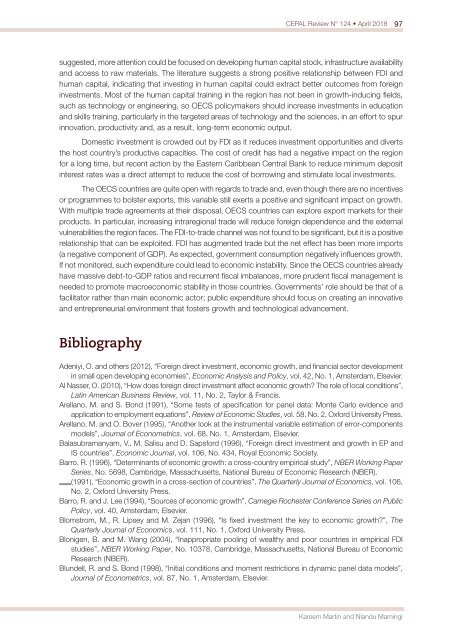CEPAL Review no. 124
April 2018
April 2018
Create successful ePaper yourself
Turn your PDF publications into a flip-book with our unique Google optimized e-Paper software.
<strong>CEPAL</strong> <strong>Review</strong> N° <strong>124</strong> • April 2018<br />
97<br />
suggested, more attention could be focused on developing human capital stock, infrastructure availability<br />
and access to raw materials. The literature suggests a strong positive relationship between FDI and<br />
human capital, indicating that investing in human capital could extract better outcomes from foreign<br />
investments. Most of the human capital training in the region has <strong>no</strong>t been in growth-inducing fields,<br />
such as tech<strong>no</strong>logy or engineering, so OECS policymakers should increase investments in education<br />
and skills training, particularly in the targeted areas of tech<strong>no</strong>logy and the sciences, in an effort to spur<br />
in<strong>no</strong>vation, productivity and, as a result, long-term eco<strong>no</strong>mic output.<br />
Domestic investment is crowded out by FDI as it reduces investment opportunities and diverts<br />
the host country’s productive capacities. The cost of credit has had a negative impact on the region<br />
for a long time, but recent action by the Eastern Caribbean Central Bank to reduce minimum deposit<br />
interest rates was a direct attempt to reduce the cost of borrowing and stimulate local investments.<br />
The OECS countries are quite open with regards to trade and, even though there are <strong>no</strong> incentives<br />
or programmes to bolster exports, this variable still exerts a positive and significant impact on growth.<br />
With multiple trade agreements at their disposal, OECS countries can explore export markets for their<br />
products. In particular, increasing intraregional trade will reduce foreign dependence and the external<br />
vulnerabilities the region faces. The FDI-to-trade channel was <strong>no</strong>t found to be significant, but it is a positive<br />
relationship that can be exploited. FDI has augmented trade but the net effect has been more imports<br />
(a negative component of GDP). As expected, government consumption negatively influences growth.<br />
If <strong>no</strong>t monitored, such expenditure could lead to eco<strong>no</strong>mic instability. Since the OECS countries already<br />
have massive debt-to-GDP ratios and recurrent fiscal imbalances, more prudent fiscal management is<br />
needed to promote macroeco<strong>no</strong>mic stability in those countries. Governments’ role should be that of a<br />
facilitator rather than main eco<strong>no</strong>mic actor; public expenditure should focus on creating an in<strong>no</strong>vative<br />
and entrepreneurial environment that fosters growth and tech<strong>no</strong>logical advancement.<br />
Bibliography<br />
Adeniyi, O. and others (2012), “Foreign direct investment, eco<strong>no</strong>mic growth, and financial sector development<br />
in small open developing eco<strong>no</strong>mies”, Eco<strong>no</strong>mic Analysis and Policy, vol. 42, No. 1, Amsterdam, Elsevier.<br />
Al Nasser, O. (2010), “How does foreign direct investment affect eco<strong>no</strong>mic growth? The role of local conditions”,<br />
Latin American Business <strong>Review</strong>, vol. 11, No. 2, Taylor & Francis.<br />
Arella<strong>no</strong>, M. and S. Bond (1991), “Some tests of specification for panel data: Monte Carlo evidence and<br />
application to employment equations”, <strong>Review</strong> of Eco<strong>no</strong>mic Studies, vol. 58, No. 2, Oxford University Press.<br />
Arella<strong>no</strong>, M. and O. Bover (1995), “A<strong>no</strong>ther look at the instrumental variable estimation of error-components<br />
models”, Journal of Eco<strong>no</strong>metrics, vol. 68, No. 1, Amsterdam, Elsevier.<br />
Balasubramanyam, V., M. Salisu and D. Sapsford (1996), “Foreign direct investment and growth in EP and<br />
IS countries”, Eco<strong>no</strong>mic Journal, vol. 106, No. 434, Royal Eco<strong>no</strong>mic Society.<br />
Barro, R. (1996), “Determinants of eco<strong>no</strong>mic growth: a cross-country empirical study”, NBER Working Paper<br />
Series, No. 5698, Cambridge, Massachusetts, National Bureau of Eco<strong>no</strong>mic Research (NBER).<br />
(1991), “Eco<strong>no</strong>mic growth in a cross-section of countries”, The Quarterly Journal of Eco<strong>no</strong>mics, vol. 106,<br />
No. 2, Oxford University Press.<br />
Barro, R. and J. Lee (1994), “Sources of eco<strong>no</strong>mic growth”, Carnegie Rochester Conference Series on Public<br />
Policy, vol. 40, Amsterdam, Elsevier.<br />
Blomstrom, M., R. Lipsey and M. Zejan (1996), “Is fixed investment the key to eco<strong>no</strong>mic growth?”, The<br />
Quarterly Journal of Eco<strong>no</strong>mics, vol. 111, No. 1, Oxford University Press.<br />
Blonigen, B. and M. Wang (2004), “Inappropriate pooling of wealthy and poor countries in empirical FDI<br />
studies”, NBER Working Paper, No. 10378, Cambridge, Massachusetts, National Bureau of Eco<strong>no</strong>mic<br />
Research (NBER).<br />
Blundell, R. and S. Bond (1998), “Initial conditions and moment restrictions in dynamic panel data models”,<br />
Journal of Eco<strong>no</strong>metrics, vol. 87, No. 1, Amsterdam, Elsevier.<br />
Kareem Martin and Nlandu Mamingi


















